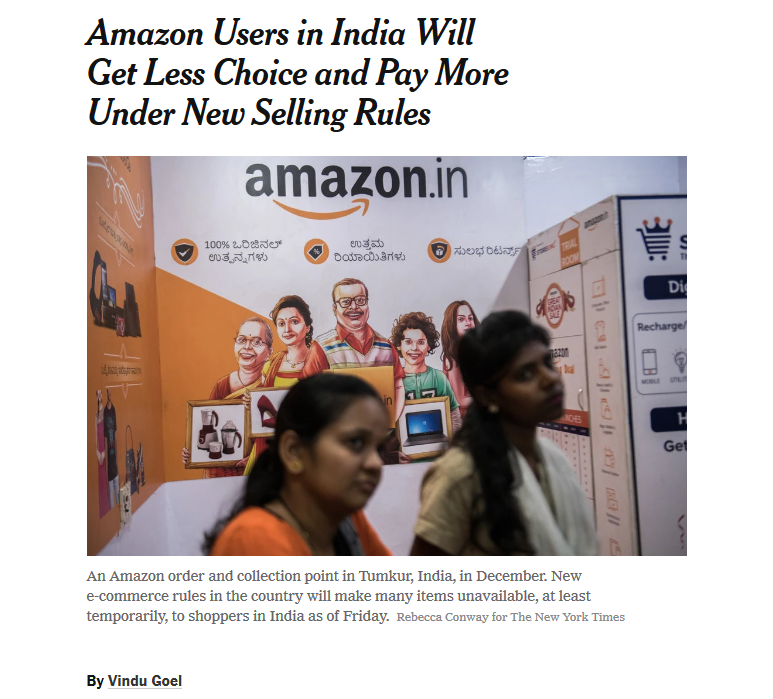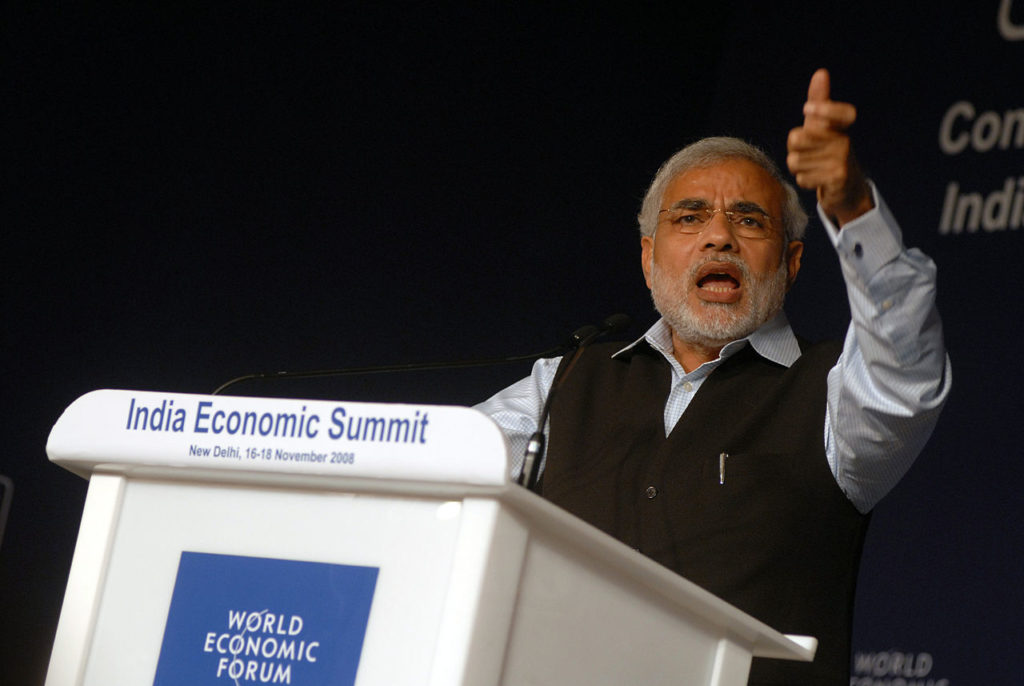 |
When India Tries to Regulate Amazon, US Media Qualms About Monopoly Disappear
view post on FAIR.org
by John C. O’Day

The “breakthrough idea” heralded by the New York Times(9/7/18)–that antitrust should be about power, not just prices–was nowhere to be seen when US media reported on India’s attempt to regulate Amazon.
Last September, the New York Times (9/7/18) ran a remarkable profile on a law student who had, as the Times characterized it, “rocked the antitrust establishment” with a “runaway bestseller” essay in the Yale Law Journal (1/17). In her manuscript, Lina Khan called into question the prevailing approach to regulating retail monopolies, focusing on a potential offender that stands heads above the rest: Amazon.com, Inc.
Khan’s work and criticism of Amazon have been covered by corporate acolytes like CNBC (4/3/18), Bloomberg (7/9/18) and Forbes (1/28/19). Now an academic fellow at Columbia Law School, she argues that the current paradigm of gauging anticompetitive practices in the retail sector according to consumer welfare is “unequipped to capture the architecture of market power in the modern economy.”
“Because online platforms serve as critical intermediaries,” she writes, “integrating across business lines positions these platforms to control the essential infrastructure on which their rivals depend.”
Khan’s conclusion—that this new kind of monopoly calls for either aggressive regulation of marketplace competition, or classifying e-commerce giants as utilities and establishing checks on their power—prompted the Times’ celebrity treatment of her as a member of an emerging class of “antitrust foot soldiers,” fighting against a corporate titan that, in the paper’s own estimation, “overwhelmingly dominates online commerce.”
Now, as India enforces new regulations in an attempt to check the monopolistic reach of Amazon and other foreign online merchants there, the New York Times, along with most corporate media voices, sings a different tune. Having forgotten Khan’s argument that consumer welfare is a poor rubric for modern anticompetitive practices in an online marketplace, the Times (1/30/19) baldly stated that “Amazon Users in India Will Get Less Choice and Pay More Under New Selling Rules.”
Other media rang similar alarm bells. The Wall Street Journal (2/1/19) reported that products have been “yanked” from Amazon in India, which has plunged the market “into chaos,” according to Bloomberg (2/1/19). CNN (2/1/19) and CNBC (2/1/19) described the “huge threat” India now poses to Amazon and its rivals like Walmart, while The Verge (2/1/19) told readers that these corporate victims have already been “hit hard” by the new restrictions. Reuters (1/31/19) went so far as to portray India as a kind of giant spider that has “caught” unsuspecting flies like Amazon and Walmart in its vicious “web.”
So while commentators are at least beginning to worry about Amazon’s emerging monopoly here at home, this concern does not extend to countries like India, exposing the underlying neocolonial disposition of corporate media: Business practices that may be intolerable for the mother country should nonetheless be encouraged at the colonial periphery.
India’s complex investment history

The New York Times (1/30/19) leaves no doubt as to how it wants you to feel about India trying to regulate Amazon.
At issue is a modification of India’s Foreign Direct Investment (FDI) policy for e-commerce announced in December, which took effect on February 1. While allowing for 100 percent FDI in the marketplace-based model of e-commerce, in which the foreign entity merely acts as a facilitator between sellers and buyers (think eBay), India banned FDI in the inventory-based model, wherein the foreign entity sells its own products directly to consumers (think Walmart.com).
Because Amazon uses its hegemony to manipulate the market in favor of products in which it has a vested interest—the “architecture of market power” about which Khan cautioned—the Indian government, in response to complaints from industry associations, clarified its rules to prohibit the sale of products when the owner of the marketplace had “equity participation” or “control on its inventory.” The updated rules also require foreign entities like Amazon to provide their services “to vendors on the platform at arm’s length and in a fair and non-discriminatory manner.”
These events are just the latest chapter in a tumultuous history of regulating FDI since India’s independence. In 1947, after wrenching itself from nearly 200 years of British colonial subjugation, India had to balance its desperate need for capital investment in development with a well-earned skepticism about the intentions of foreign business.
The new indigenous government nationalized industries deemed critical to India’s strategic interests, such as the energy and military sectors. Niti Bhasin of the Delhi School of Economics wrote that “the prevailing mood in independent India was one of preserving and consolidating freedom, and not permitting once again any sort of foreign domination, political or economic.”
Over subsequent decades, India’s regulation of FDI in its economy fluctuated. Foreign participation was largely encouraged across economic sectors, though the government informally prodded companies to include local equity in their investments. In the late 1960s and early ’70s, however, India codified these equity requirements and began to crack down on monopolistic behavior, leading to an exodus of large multinational corporations from the Indian marketplace—including, famously, the departure of Coca-Cola in 1977.
These strict regulations on FDI were gradually relaxed over time until the Indian economy underwent a radical transformation in the 1990s, when “pressure of the IMF and World Bank to liberalize the Indian economy forced the government to accelerate the pace of liberalization,” according to Amar K.J.R. Nayak of the Xavier Institute of Management, Bhubaneswar. Coca-Cola, which re-entered India in 1993, now controls the largest share of the soft drink market there, including ownership of Thums Up, the indigenous cola brand that took Coke’s place 40 years ago when the US-based soda abandoned ship.
Hardly an anti-capitalist, Narendra Modi, the current prime minister of India, could be seen as the culmination of this more recent history. After coming to power in 2014 with the promise of continued economic liberalization, the Modi government last January instituted automatic approval for 100 percent FDI in aviation and construction, as well as single-brand retail, and is looking to do the same for theinsurance industry.
Although understanding India’s unique historical struggle to secure its political and economic sovereignty is essential to comprehending the dynamics of the present standoff, corporate media chose instead to paint a picture for readers using more familiar—but fundamentally erroneous—analogies to a Western context.
Equivocating on ‘brick and mortar’
Whenever abuses by monopolies become so egregious as to provoke popular resistance, corporate media’s shallow coverage tends to cast aside the real story in favor of a staged battle royale between moguls (FAIR.org, 8/18/17). A similar trend emerged once again as India’s position on FDI in e-commerce evolved.
Rather than forefront the concerns of India’s myriad independent retailers about the potentially devastating effect of foreign-controlled e-commerce on their livelihoods, Reuters (1/24/19) led the story as a geopolitical “tussle,” “the latest in a number of US protests over Indian government policies which impact American companies.” Fortune (1/5/19) spun a heartwarming tale of erstwhile rivals “teaming up” to fight the uppity Indian government. “It isn’t all bad for Amazon and Walmart,” they reassured readers, as there may yet be hope for finding loopholes in the new restrictions.
More common was an effort to reduce the “tussle” to a competition between US billionaires Jeff Bezos and the Walton family, on the one hand, and Indian billionaires like Mukesh Ambani, owner of Mumbai-based Reliance Industries, on the other. Bloomberg (7/5/18), the Telegraph (1/18/19) and Quartz(1/29/19) each ran profiles on Ambani in the context of India’s new FDI rules, with the latter extolling that “Reliance could not have found a better time to launch its e-commerce business.”
The New York Times (4/7/16) has explained to its readers that, “as in the United States, in India brick-and-mortar retailers have expressed alarm at the growth of e-commerce.” While for an American audience, this depiction may conjure up memories of Amazon winning out over legacy retail corporations like Barnes & Noble, in India nothing could be further from reality.
According to the Indian government’s Department of Commerce, in 2017 e-commerce represented 3 percent of India’s overall retail economy, while “organized retail,” its term for large firms, including corporate brick-and-mortar establishments akin to Barnes and Noble, took up another 9 percent. In other words, a whopping 88 percent of retail commerce in India is conducted in so-called “mom and pop” stores, the likes of which are little more than a distant memory in the United States.
The “unorganized” or “traditional” retail sector in India is defined as “unincorporated private enterprises owned by individuals or households…with less than ten total workers.” By comparison, according to the latest available US Census data, American firms with fewer than ten workers amount to just 10 percent of total retail receipts, almost the exact opposite of India.
While Mukesh Ambani certainly has a large stake in the future of Indian e-commerce, his business dwells in that meager 12 percent slice of India’s overall retail marketplace. Meanwhile, tens of millions of working Indians see their livelihoods hanging in the balance.
Recalling the decimation of American mom-and-pop shops would arouse sympathy among a US audience but, sadly, erasing the plight of ordinary Indians isn’t the only diversionary tactic that corporate media have employed to spin this story.
Universalizing Trumpism

Narendra Modi (cc photo: World Economic Forum/Norbert Schiller)
Narendra Modi, who is pushing forward with regulations on foreign e-commerce, has been the subject of serious criticism, both within his country and abroad. Many hold him at least indirectly responsible for pogroms that killed upwards of 2,000 people while he was chief minister of the Indian state of Gujarat, and his tenure as PM has also seen considerable controversy.
Despite hailing from western India, Modi symbolically contested for his seat in parliament from the ancient holy city of Varanasi, sweeping his Bharatiya Janata Party (Indian People’s Party) into control on a platform of Hindutva nationalism, atop what the local press coined as a “Modi wave.” Since the 2014 national election, lynchings by right-wing “cow vigilantes” have increased , while some journalists and scholars have warned of new threats to freedom of speech there.
At the time of his ascension, Modi was described as “a corporate candidate” by Arundhati Roy, who saw the election as a contest deciding “which corporation will come to power.” Vijay Prashad, a historian at American University of Beirut, called Modi’s candidacy the “worst of all worlds” for exploiting sectarianism and anti-incumbency to advance a neoliberal economic agenda that would make even the Clintons blush (Common Dreams, 5/16/14).
Grasping as usual for the simplest possible narrative, however, Western corporate media have been content to style Modi as the Indian counterpart to a more fashionable villain, US President Donald Trump. The New York Times (10/16/16), New Yorker (1/18/17) and Atlantic (12/26/18), for example, have linked Modi and Trump as fellow “strong men” who employ “anti-bureaucracy and country-first language” to rile up their constituencies.
Albeit accurate with regard to certain rhetorical strategies, it is hard to see what relevance Trump’s political likeness to Modi bears on the Indian president’s position toward Amazon’s potential takeover of his country’s online marketplace. After all, as Reuters reported, Trump’s State Department and Office of the United States Trade Representative coordinated a lobbying effort against the new rules.
In other words, Modi’s decision to restrict FDI in inventory-based e-commerce, despite his more general openness to economic liberalization, and Trump’s support of US firms, despite his earlier threats to trust-bust Amazon, together represent a break from the very narratives corporate media are nevertheless injecting into the story.
That conceptual incongruity did not stop Bloomberg (2/4/19) from analyzing the matter in terms of Trumpism. “In India, populist fervor and fear is also working against Amazon,” they wrote, as Modi-qua-Trump “seems bent on appeasing millions of mom-and-pop store owners who make up a powerful voting block.” Euronews (1/25/19) similarly used Modi’s association with right-wing groups in a veiled attempt to discredit India’s resistance to Western economic imperialism.
With Amazon haunted by the threat of a leader “bent on appeasing” the vast majority of his country’s retail businesses in the face of potential corporate annihilation, it is little surprise that Jeff Bezos’ personal newspaper syndicated Bloomberg’s story (Washington Post, 2/4/19). As Adam Johnson documented, more broadly, US outlets lap up opportunities to render Bezos and his company in a flattering light (FAIR.org, 7/28/17). In this case, the alignment of Modi with Trump is the spoonful of sugar that helps corporate media’s Amazon apologetics go down.
Neocolonial legacies
As novel as Lina Khan’s approach to e-commerce monopolies may be, the phenomenon of US corporations taking control of “the essential infrastructure on which their rivals depend” is certainly not new, and it is a story with which India is all too familiar.
Throughout the 1950s and ’60s, Indian agriculture underwent a radical transformation as part of what is popularly called “The Green Revolution,” led by the US government, the World Bank, and the Ford and Rockefeller foundations. While the figurehead of the project, Norman Borlaug, was eventually awarded the Nobel Peace Prize for his “miracle seeds” in 1970, not everyone views the aftermath of revolutionizing India’s largest economic sector as a miracle.
The environmentalist and scholar Vandana Shiva argues that the program hoisted onto India shifted its agricultural system from “an indigenous and ecological model to an exogenous and high-input one,” by introducing crop varieties and methods developed in partnership with US corporations that relied on pesticides and fertilizers produced by those same corporations to thrive. In Shiva’s view, this new dynamic “brought violence instead of peace, dependence instead of self-reliance and autonomy.”
Writing in 1991, at the dawn of India’s rapid economic liberalization, Shiva warned of further corporate encroachment into its indigenous industries. “We can draw some lessons from history about how technological change initiated by a special interest brings development to that interest group while creating underdevelopment for others,” she reflected.
Modi likely has history on his mind as he assesses another potential foreign-sponsored revolution of his country’s economy. As Shiva foretold, India’s agricultural industry is still plagued by political and economic strife and, notwithstanding his “populism,” ongoing discontent among farmers may well be Modi’s political undoing in the upcoming national election this year.
United with Trump against sovereignty
Khan, acting in the “antitrust foot soldier” capacity acclaimed by the New York Times, weighed in on their coverage of the new e-commerce FDI rules taking force in India. “Interestingly, @nytimesdescribes India’s rule as ‘protectionism,’” she wrote on Twitter, highlighting corporate media’s tendency to lump Modi in with universal Trumpism. “But this sort of structural separation has been a key principle in US competition policy. For example, Congress in 1906 passed a law prohibiting railroads from transporting goods they owned,” she noted.
Despite their openness to a new conceptualization of antitrust that is responsive to the dynamics of modern industry in the United States, corporate media are aghast at the implementation of such an approach to forestall US monopolies in another country like India. And despite adopting a banner of vanguard resistance against Trumpism, corporate media position themselves alongside Trump in his effort to undermine India’s economic sovereignty.
The only way to explain these inconsistencies is to acknowledge the latent neocolonial attitude that governs corporate media’s treatment of familiar issues whenever they cross the US border. The potential consumers in corporate media understand the damage already wrought by retail monopolies here, as well as the risks posed by Amazon’s dominance of the online market. Nevertheless, as potential shareholders, they are eager to see Amazon tap that heretofore unexploited 88 percent of India’s retail economy (CNBC, 1/31/19).
What corporate media find at least questionable for the homeland, they nonetheless encourage in the colonial periphery, because Indian wealth is meant to be extracted by the West.
No one yet knows what the future will hold for India’s online retail economy, or the US corporations salivating at the chance to take a bite out of it, but it should go without saying that this future is India’s to decide for itself. US media need to quit the role of corporate cheerleader for once and leave Indians to it.
|
|
No comments:
Post a Comment